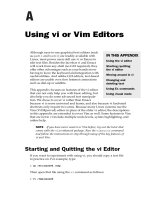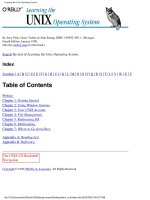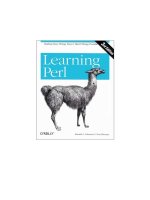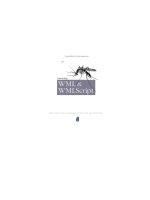o'reilly - learning the vi and vim editors 7th edition
Bạn đang xem bản rút gọn của tài liệu. Xem và tải ngay bản đầy đủ của tài liệu tại đây (6.93 MB, 494 trang )
Learning the vi and Vim Editors
Other resources from O’Reilly
Related titles
vi Editor Pocket Reference
Unix in a Nutshell
Classic Shell Scripting
The Productive Programmer
Unix Power Tools
Mac OS X for Unix Geeks
oreilly.com
oreilly.com is more than a complete catalog of O’Reilly books.
You’ll also find links to news, events, articles, weblogs, sample
chapters, and code examples.
oreillynet.com is the essential portal for developers interested in
open and emerging technologies, including new platforms, pro-
gramming languages, and operating systems.
Conferences
O’Reilly Media brings diverse innovators together to nurture
the ideas that spark revolutionary industries. We specialize in
documenting the latest tools and systems, translating the inno-
vator’s knowledge into useful skills for those in the trenches.
Visit conferences.oreilly.com for our upcoming events.
Safari Bookshelf (safari.oreilly.com) is the premier online refer-
ence library for programmers and IT professionals. Conduct
searches across more than 1,000 books. Subscribers can zero in
on answers to time-critical questions in a matter of seconds.
Read the books on your Bookshelf from cover to cover or sim-
ply flip to the page you need. Try it today for free.
SEVENTH EDITION
Learning the vi and Vim Editors
Arnold Robbins, Elbert Hannah, and Linda Lamb
Tomcat
™
The Definitive Guide
Jason Brittain and Ian F. Darwin
Beijing
•
Cambridge
•
Farnham
•
Köln
•
Sebastopol
•
Taipei
•
Tokyo
main.title Page iii Monday, May 19, 2008 11:21 AM
Learning the vi and Vim Editors, Seventh Edition
by Arnold Robbins, Elbert Hannah, and Linda Lamb
Copyright © 2008 Arnold Robbins, Elbert Hannah, and Linda Lamb. All rights reserved.
Printed in the United States of America.
Published by O’Reilly Media, Inc., 1005 Gravenstein Highway North, Sebastopol, CA 95472.
O’Reilly books may be purchased for educational, business, or sales promotional use. Online editions
are also available for most titles ( ). For more information, contact our corporate/
institutional sales department: 800-998-9938 or
Editor: Andy Oram
Production Editor: Sarah Schneider
Copyeditor: Genevieve d’Entremont
Proofreader: Sarah Schneider
Indexer: Joe Wizda
Cover Designer: Karen Montgomery
Interior Designer: David Futato
Illustrator: Robert Romano
Printing History:
July 2008: Seventh Edition
November 1998: Sixth Edition
October 1990: Fifth Edition
June 1988: Fourth Edition
August 1987: Third Edition
April 1986: Second Edition
February 1986: First Edition
Nutshell Handbook, the Nutshell Handbook logo, and the O’Reilly logo are registered trademarks of
O’Reilly Media, Inc. Learning the vi and Vim Editors, 7th Edition, the image of a tarsier, and related trade
dress are trademarks of O’Reilly Media, Inc.
Many of the designations uses by manufacturers and sellers to distinguish their products are claimed as
trademarks. Where those designations appear in this book, and O’Reilly Media, Inc. was aware of a
trademark claim, the designations have been printed in caps or initial caps.
While every precaution has been taken in the preparation of this book, the publisher and authors assume
no responsibility for errors or omissions, or for damages resulting from the use of the information con-
tained herein.
ISBN: 978-0-596-52983-3
[M]
1215018617
To my wife, Miriam, for your love, patience, and
support.
—Arnold Robbins, Sixth and Seventh Editions
Table of Contents
Preface . . . . . . . . . . . . . . . . . . . . . . . . . . . . . . . . . . . . . . . . . . . . . . . . . . . . . . . . . . . . . . . . xiii
Part I. Basic and Advanced vi
1. The vi Text Editor . . . . . . . . . . . . . . . . . . . . . . . . . . . . . . . . . . . . . . . . . . . . . . . . . . . . . . . . 3
A Brief Historical Perspective 5
Opening and Closing Files 6
Quitting Without Saving Edits 10
2. Simple Editing . . . . . . . . . . . . . . . . . . . . . . . . . . . . . . . . . . . . . . . . . . . . . . . . . . . . . . . . . 13
vi Commands 13
Moving the Cursor 14
Simple Edits 18
More Ways to Insert Text 30
Joining Two Lines with J 31
Review of Basic vi Commands 32
3. Moving Around in a Hurry . . . . . . . . . . . . . . . . . . . . . . . . . . . . . . . . . . . . . . . . . . . . . . . . 35
Movement by Screens 35
Movement by Text Blocks 38
Movement by Searches 39
Movement by Line Number 43
Review of vi Motion Commands 44
4. Beyond the Basics . . . . . . . . . . . . . . . . . . . . . . . . . . . . . . . . . . . . . . . . . . . . . . . . . . . . . . 47
More Command Combinations 47
Options When Starting vi 48
Making Use of Buffers 51
Marking Your Place 52
Other Advanced Edits 53
Review of vi Buffer and Marking Commands 53
vii
5. Introducing the ex Editor . . . . . . . . . . . . . . . . . . . . . . . . . . . . . . . . . . . . . . . . . . . . . . . . 55
ex Commands 55
Editing with ex 58
Saving and Exiting Files 63
Copying a File into Another File 65
Editing Multiple Files 65
6. Global Replacement . . . . . . . . . . . . . . . . . . . . . . . . . . . . . . . . . . . . . . . . . . . . . . . . . . . . 71
Confirming Substitutions 72
Context-Sensitive Replacement 73
Pattern-Matching Rules 74
Pattern-Matching Examples 81
A Final Look at Pattern Matching 89
7. Advanced Editing . . . . . . . . . . . . . . . . . . . . . . . . . . . . . . . . . . . . . . . . . . . . . . . . . . . . . . . 95
Customizing vi 95
Executing Unix Commands 99
Saving Commands 103
Using ex Scripts 114
Editing Program Source Code 120
8. Introduction to the vi Clones . . . . . . . . . . . . . . . . . . . . . . . . . . . . . . . . . . . . . . . . . . . . 125
And These Are My Brothers, Darrell, Darrell, and Darrell 125
Multiwindow Editing 126
GUI Interfaces 127
Extended Regular Expressions 128
Enhanced Tags 129
Improved Facilities 134
Programming Assistance 138
Editor Comparison Summary 140
Nothing Like the Original 141
A Look Ahead 141
Part II. Vim
9. Vim (vi Improved): An Introduction . . . . . . . . . . . . . . . . . . . . . . . . . . . . . . . . . . . . . . . 145
Overview 146
Where to Get Vim 150
Getting Vim for Unix and GNU/Linux 151
Getting Vim for Windows Environments 156
Getting Vim for the Macintosh Environment 157
Other Operating Systems 157
viii | Table of Contents
Aids and Easy Modes for New Users 157
Summary 158
10. Major Vim Improvements over vi . . . . . . . . . . . . . . . . . . . . . . . . . . . . . . . . . . . . . . . . . 159
Built-in Help 159
Startup and Initialization Options 160
New Motion Commands 167
Extended Regular Expressions 169
Customizing the Executable 171
11. Multiple Windows in Vim . . . . . . . . . . . . . . . . . . . . . . . . . . . . . . . . . . . . . . . . . . . . . . . 173
Initiating Multiwindow Editing 174
Opening Windows 177
Moving Around Windows (Getting Your Cursor from Here to There) 180
Moving Windows Around 181
Resizing Windows 183
Buffers and Their Interaction with Windows 186
Playing Tag with Windows 190
Tabbed Editing 191
Closing and Quitting Windows 192
Summary 193
12. Vim Scripts . . . . . . . . . . . . . . . . . . . . . . . . . . . . . . . . . . . . . . . . . . . . . . . . . . . . . . . . . . . 195
What’s Your Favorite Color (Scheme)? 195
Dynamic File Type Configuration Through Scripting 205
Some Additional Thoughts About Vim Scripting 213
Resources 218
13. Graphical Vim (gvim) . . . . . . . . . . . . . . . . . . . . . . . . . . . . . . . . . . . . . . . . . . . . . . . . . . . 219
General Introduction to gvim 220
Customizing Scrollbars, Menus, and Toolbars 225
gvim in Microsoft Windows 236
gvim in the X Window System 237
GUI Options and Command Synopsis 237
14. Vim Enhancements for Programmers . . . . . . . . . . . . . . . . . . . . . . . . . . . . . . . . . . . . . 239
Folding and Outlining (Outline Mode) 240
Auto and Smart Indenting 251
Keyword and Dictionary Word Completion 259
Tag Stacking 268
Syntax Highlighting 270
Compiling and Checking Errors with Vim 279
Some Final Thoughts on Vim for Writing Programs 284
Table of Contents | ix
15. Other Cool Stuff in Vim . . . . . . . . . . . . . . . . . . . . . . . . . . . . . . . . . . . . . . . . . . . . . . . . . 285
Editing Binary Files 285
Digraphs: Non-ASCII Characters 287
Editing Files in Other Places 289
Navigating and Changing Directories 290
Backups with Vim 292
HTML Your Text 293
What’s the Difference? 294
Undoing Undos 296
Now, Where Was I? 297
What’s My Line (Size)? 300
Abbreviations of Vim Commands and Options 302
A Few Quickies (Not Necessarily Vim-Specific) 303
More Resources 304
Part III. Other vi Clones
16. nvi: New vi . . . . . . . . . . . . . . . . . . . . . . . . . . . . . . . . . . . . . . . . . . . . . . . . . . . . . . . . . . . 307
Author and History 307
Important Command-Line Arguments 308
Online Help and Other Documentation 309
Initialization 309
Multiwindow Editing 310
GUI Interfaces 311
Extended Regular Expressions 311
Improvements for Editing 312
Programming Assistance 315
Interesting Features 315
Sources and Supported Operating Systems 315
17. Elvis . . . . . . . . . . . . . . . . . . . . . . . . . . . . . . . . . . . . . . . . . . . . . . . . . . . . . . . . . . . . . . . . . 317
Author and History 317
Important Command-Line Arguments 317
Online Help and Other Documentation 319
Initialization 319
Multiwindow Editing 320
GUI Interfaces 323
Extended Regular Expressions 328
Improved Editing Facilities 328
Programming Assistance 332
Interesting Features 335
elvis Futures 340
x | Table of Contents
Sources and Supported Operating Systems 340
18. vile: vi Like Emacs . . . . . . . . . . . . . . . . . . . . . . . . . . . . . . . . . . . . . . . . . . . . . . . . . . . . . 343
Authors and History 343
Important Command-Line Arguments 344
Online Help and Other Documentation 345
Initialization 346
Multiwindow Editing 347
GUI Interfaces 349
Extended Regular Expressions 357
Improved Editing Facilities 359
Programming Assistance 365
Interesting Features 368
Sources and Supported Operating Systems 374
Part IV. Appendixes
A. The vi, ex, and Vim Editors . . . . . . . . . . . . . . . . . . . . . . . . . . . . . . . . . . . . . . . . . . . . . . 377
B. Setting Options . . . . . . . . . . . . . . . . . . . . . . . . . . . . . . . . . . . . . . . . . . . . . . . . . . . . . . . 415
C. Problem Checklists . . . . . . . . . . . . . . . . . . . . . . . . . . . . . . . . . . . . . . . . . . . . . . . . . . . . 431
D. vi and the Internet . . . . . . . . . . . . . . . . . . . . . . . . . . . . . . . . . . . . . . . . . . . . . . . . . . . . . 435
Index . . . . . . . . . . . . . . . . . . . . . . . . . . . . . . . . . . . . . . . . . . . . . . . . . . . . . . . . . . . . . . . . . . . . . 447
Table of Contents | xi
Preface
Text editing is one of the most common tasks on any computer system, and vi is one
of the most useful standard text editors on a system. With vi you can create new files
or edit any existing text-only file.
vi, like many of the classic utilities developed during the early years of Unix, has a
reputation for being hard to navigate. Bram Moolenaar’s enhanced clone, Vim (“vi
Improved”), has gone a long way toward removing reasons for such impressions. Vim
includes countless conveniences, visual guides, and help screens. It has become prob-
ably the most popular version of vi, so this seventh edition of this book devotes seven
new chapters to it in Part II, Vim. However, many other worthy clones of vi also exist;
we cover three of them in Part III, Other vi Clones.
Scope of This Book
This book consists of 18 chapters and 4 appendixes, divided into 4 parts. Part I, Basic
and Advanced vi, is designed to get you started using vi quickly, and to follow up with
advanced skills that will let you use it effectively.
The first two chapters, Chapter 1, The vi Text Editor, and Chapter 2, Simple Editing,
present some simple vi commands with which you can get started. You should practice
these until they are second nature. You could stop reading at the end of Chapter 2,
having learned some elementary editing tools.
But vi is meant to do a lot more than rudimentary word processing; the variety of
commands and options enables you to shortcut a lot of editing drudgery. Chapter 3,
Moving Around in a Hurry, and Chapter 4, Beyond the Basics, concentrate on easier
ways to do tasks. During your first reading, you’ll get at least an idea of what vi can do
and what commands you might harness for your specific needs. Later, you can come
back to these chapters for further study.
Chapter 5, Introducing the ex Editor, Chapter 6, Global Replacement, and Chapter 7,
Advanced Editing, provide tools that help you shift more of the editing burden to the
computer. They introduce you to the ex line editor underlying vi, and they show you
how to issue ex commands from within vi.
xiii
Chapter 8, Introduction to the vi Clones, provides an introduction to the extensions
available in the four vi clones covered in this book. It centralizes in one place the
descriptions of multiwindow editing, GUI interfaces, extended regular expressions,
facilities that make editing easier, and several other features, providing a roadmap to
what follows in the rest of this book. It also provides a pointer to source code for the
original vi, which can be compiled easily on modern Unix systems (including GNU/
Linux).
Part II, Vim, describes Vim, the most popular vi clone in the early part of the 21st
century.
Chapter 9, Vim (vi Improved): An Introduction, provides a general introduction to Vim,
including where to get binary versions for popular operating systems and some of the
different ways to use Vim.
Chapter 10, Major Vim Improvements over vi, describes the major improvements in
Vim over vi, such as built-in help, control over initialization, additional motion com-
mands, and extended regular expressions.
Chapter 11, Multiple Windows in Vim, focuses on multiwindow editing, which is per-
haps the most significant additional feature over standard vi. This chapter provides all
the details on creating and using multiple windows.
Chapter 12, Vim Scripts, looks into the Vim command language, which lets you write
scripts to customize and tailor Vim to suit your needs. Much of Vim’s ease of use “out
of the box” comes from the large number of scripts that other users have already written
and contributed to the Vim distribution.
Chapter 13, Graphical Vim (gvim), looks at Vim in modern GUI environments, such
as those that are now standard on commercial Unix systems, GNU/Linux and other
Unix work-alikes, and MS Windows.
Chapter 14, Vim Enhancements for Programmers, focuses on Vim’s use as a program-
mer’s editor, above and beyond its facilities for general text editing. Of particular value
are the folding and outlining facilities, smart indenting, syntax highlighting, and edit-
compile-debug cycle speedups.
Chapter 15, Other Cool Stuff in Vim, is a bit of a catch-all chapter, covering a number
of interesting points that don’t fit into the earlier chapters.
Part III, Other vi Clones, describes three other popular vi clones: nvi, elvis, and vile.
Chapter 16, nvi: New vi, Chapter 17, Elvis, and Chapter 18, vile: vi Like Emacs, cover
the various vi clones—nvi, elvis, and vile—showing you how to use their extensions
to vi and discussing the features that are specific to each one.
Part IV, Appendixes, provides useful reference material.
xiv | Preface
Appendix A, The vi, ex, and Vim Editors, lists all vi and ex commands, sorted by func-
tion. It also provides an alphabetical list of ex commands. Selected vi and ex commands
from Vim are also included.
Appendix B, Setting Options, lists set command options for vi and for all four clones.
Appendix C, Problem Checklists, consolidates checklists found earlier in the book.
Appendix D, vi and the Internet, describes vi’s place in the larger Unix and Internet
culture.
How the Material Is Presented
Our philosophy is to give you a good overview of what we feel are vi survival materials
for the new user. Learning a new editor, especially an editor with all the options of
vi, can seem like an overwhelming task. We have made an effort to present basic con-
cepts and commands in an easy-to-read and logical manner.
After providing the basics for vi, which are usable everywhere, we move on to cover
Vim in depth. We then round out our coverage of the vi landscape by looking at nvi,
elvis, and vile. The following sections describe the conventions used in this book.
Discussion of vi Commands
A picture of a keyboard button, like the one on the left, marks the main discussion
of that particular keyboard command or of related commands. You will find a
brief introduction to the main concept before it is broken down into task-oriented
sections. We then present the appropriate command to use in each case, along with a
description of the command and the proper syntax for using it.
Conventions
In syntax descriptions and examples, what you would actually type is shown in the
Courier font, as are all command names. Filenames are also shown in Courier, as are
program options. Variables (which you would not type literally, but would replace with
an actual value when you type the command) are shown in Courier italic. Brackets
indicate that a variable is optional. For example, in the syntax line:
vi [filename]
filename would be replaced by an actual filename. The brackets indicate that the vi
command can be invoked without specifying a filename at all. The brackets themselves
are not typed.
i
Preface | xv
Certain examples show the effect of commands typed at the Unix shell prompt. In such
examples, what you actually type is shown in Courier Bold, to distinguish it from the
system response. For example:
$ ls
ch01.xml ch02.xml ch03.xml ch04.xml
In code examples, italic indicates a comment that is not to be typed. Otherwise, italic
introduces special terms and emphasizes anything that needs emphasis.
Following traditional Unix documentation convention, references of the form
printf(3) refer to the online manual (accessed via the man command). This example refers
to the entry for the printf( ) function in section 3 of the manual (you would type man
3 printf on most systems to see it).
Keystrokes
Special keystrokes are shown in a box. For example:
iWith a ESC
Throughout the book, you will also find columns of vi commands and their results:
Keystrokes Results
ZZ
"practice" [New file] 6 lines, 320 characters
Give the write and save command, ZZ. Your file is saved as a regular Unix file.
In the preceding example, the command ZZ is shown in the left column. In the window
to the right is a line (or several lines) of the screen that show the result of the command.
Cursor position is shown in reverse video. In this instance, since ZZ saves and writes
the file, you see the status line shown when a file is written; the cursor position is not
shown. Below the window is an explanation of the command and its result.
Sometimes vi commands are issued by pressing the CTRL key and another key si-
multaneously. In the text, this combination keystroke is usually written within a box
(for example, CTRL-G). In code examples, it is written by preceding the name of the
key with a caret (^). For example, ^G means to hold down CTRL while pressing the
G key.
Problem Checklist
A problem checklist is included in those sections where you may run into some trouble.
You can skim these checklists and go back to them when you actually encounter a
problem. All of the problem checklists are also collected in Appendix C, for ease of
reference.
xvi | Preface
What You Need to Know Before Starting
This book assumes you have already read Learning the Unix Operating System
(O’Reilly), or some other introduction to Unix. You should already know how to:
• Log in and log out
• Enter Unix commands
• Change directories
• List files in a directory
• Create, copy, and remove files
Familiarity with grep (a global search program) and wildcard characters is also helpful.
Comments and Questions
Please address comments and questions concerning this book to the publisher:
O’Reilly Media, Inc.
1005 Gravenstein Highway North
Sebastopol, CA 95472
800-998-9938 (in the United States or Canada)
707-829-0515 (international or local)
707-829-0104 (fax)
To ask technical questions or comment on the book, send email to:
The web site for this book lists examples, errata, and plans for future editions. You can
access this page at:
/>For more information about our books, conferences, software, resource centers, and
the O’Reilly Network, see our web site:
Safari® Books Online
When you see a Safari® Books Online icon on the cover of your favorite
technology book, that means the book is available online through the
O’Reilly Network Safari Bookshelf.
Safari offers a solution that’s better than e-books. It’s a virtual library that lets you easily
search thousands of top tech books, cut and paste code samples, download chapters,
Preface | xvii
and find quick answers when you need the most accurate, current information. Try it
for free at .
About the Previous Editions
In the fifth edition of this book (then called Learning the vi Editor), the ex editor com-
mands were first discussed more fully. In Chapters 5, 6, and 7, the complex features of
ex and vi were clarified by adding more examples, in topics such as regular expression
syntax, global replacement, .exrc files, word abbreviations, keyboard maps, and edit-
ing scripts. A few of the examples were drawn from articles in Unix World magazine.
Walter Zintz wrote a two-part tutorial
*
on vi that taught us a few things we didn’t
know, and that also had a lot of clever examples illustrating features we did already
cover in the book. Ray Swartz also had a helpful tip in one of his columns.
†
We are
grateful for the ideas in these articles.
The sixth edition of Learning the vi Editor introduced coverage of four freely available
“clones,” or work-alike editors. Many of them have improvements over the original
vi. One could thus say that there is a “family” of vi editors, and the book’s goal was
to teach you what you need to know to use them. That edition treated nvi, Vim,
elvis, and vile equally.
The sixth edition also added the following features:
• Many minor corrections and additions were made to the basic text.
• For each chapter where appropriate, a command summary was added at the end.
• New chapters covered each vi clone, the features and/or extensions common to
two or more of the clones, and multiwindow editing.
• The chapters for each vi clone described a bit of that program’s history and goals,
its unique features, and where to get it.
• A new appendix described vi’s place in the larger Unix and Internet culture.
Preface to the Seventh Edition
This seventh edition of Learning the vi and Vim Editors retains all the good features of
the sixth edition. Time has proven Vim to be the most popular vi clone, so this edition
adds considerably expanded coverage of that editor (and gives it a place in the title).
However, to be relevant for as many users as possible, we have retained and updated
the material on nvi, elvis, and vile.
*
“vi Tips for Power Users,” Unix World, April 1990; and “Using vi to Automate Complex Edits,” Unix
World, May 1990. Both articles by Walter Zintz. (See Appendix D for the web location of these articles.)
†
“Answers to Unix,” Unix World, August 1990.
xviii | Preface
What’s New
The following features are new for this edition:
• Once again, we have corrected errors in the basic text.
• Seven new chapters provide exhaustive coverage of Vim.
• The material on nvi, elvis, and vile has been brought up-to-date.
• The previous edition’s two reference appendixes on ex and vi have been condensed
into one and now contain selected additional material on Vim.
• The other appendixes have been updated as well.
Versions
The following programs were used for testing out various vi features:
• The Solaris version of vi for a “reference” version of Unix vi
• Version 1.79 of Keith Bostic’s nvi
• Version 2.2 of Steve Kirkendall’s elvis
• Version 7.1 of Bram Moolenaar’s Vim
• Version 9.6 of vile, by Kevin Buettner, Tom Dickey, and Paul Fox
Acknowledgments from the Sixth Edition
First and foremost, thanks to my wife, Miriam, for taking care of the kids while I was
working on this book, particularly during the “witching hours” right before meal times.
I owe her large amounts of quiet time and ice cream.
Paul Manno, of the Georgia Tech College of Computing, provided invaluable help in
pacifying my printing software. Len Muellner and Erik Ray of O’Reilly & Associates
helped with the SGML software. Jerry Peek’s vi macros for SGML were invaluable.
Although all of the programs were used during the preparation of the new and revised
material, most of the editing was done with Vim versions 4.5 and 5.0 under GNU/Linux
(Red Hat 4.2).
Thanks to Keith Bostic, Steve Kirkendall, Bram Moolenaar, Paul Fox, Tom Dickey, and
Kevin Buettner, who reviewed the book. Steve Kirkendall, Bram Moolenaar, Paul Fox,
Tom Dickey, and Kevin Buettner also provided important parts of Chapters 8 through
12. (These chapter numbers refer to the sixth edition.)
Without the electricity being generated by the power company, doing anything with a
computer is impossible. But when the electricity is there, you don’t stop to think about
it. So too when writing a book—without an editor, nothing happens, but when the
editor is there doing her job, it’s easy to forget about her. Gigi Estabrook at O’Reilly is
Preface | xix
a true gem. It’s been a pleasure working with her, and I appreciate everything she’s
done and continues to do for me.
Finally, many thanks to the production team at O’Reilly & Associates.
—Arnold Robbins
Ra’anana, ISRAEL
June 1998
Acknowledgments for the Seventh Edition
Once again, Arnold thanks his wife, Miriam, for her love and support. The size of his
quiet time and ice cream debt continues to grow. In addition, thanks to J.D. “Illiad”
Frazer for the great User Friendly cartoons.
‡
Elbert would like to thank Anna, Cally, Bobby, and his parents for staying excited about
his work through the tough times. Their enthusiasm was contagious and appreciated.
Thanks to Keith Bostic and Steve Kirkendall for providing input on revising their edi-
tors’ chapters. Tom Dickey provided significant input for revising the chapter on
vile and the table of set options in Appendix B. Bram Moolenaar (the author of Vim)
reviewed the book this time around as well. Robert P.J. Day, Matt Frye, Judith Myerson,
and Stephen Figgins provided important review comments throughout the text.
Arnold and Elbert would both like to thank Andy Oram and Isabel Kunkle for their
work as editors, and all of the tools and production staff at O’Reilly Media.
—Arnold Robbins
Nof Ayalon, ISRAEL
2008
—Elbert Hannah
Kildeer, Illinois USA
2008
‡
See if you’ve never heard of User Friendly.
xx | Preface
PART I
Basic and Advanced vi
Part I is designed to get you started quickly with the vi editor and to provide the ad-
vanced skills that will let you use vi most effectively. These chapters cover the original,
core vi and provide commands you can use on any version; later chapters cover popular
clones. This part contains the following chapters:
• Chapter 1, The vi Text Editor
• Chapter 2, Simple Editing
• Chapter 3, Moving Around in a Hurry
• Chapter 4, Beyond the Basics
• Chapter 5, Introducing the ex Editor
• Chapter 6, Global Replacement
• Chapter 7, Advanced Editing
• Chapter 8, Introduction to the vi Clones
CHAPTER 1
The vi Text Editor
Unix
*
has a number of editors that can process the contents of text files, whether those
files contain data, source code, or sentences. There are line editors, such as ed and ex,
which display a line of the file on the screen; and there are screen editors, such as vi
and Emacs, which display a part of the file on your terminal screen. Text editors based
on the X Window System are also commonly available and are becoming increasing
popular. Both GNU Emacs and its derivative, XEmacs, provide multiple X windows;
two interesting alternatives are the sam and Acme editors from Bell Labs. Vim also
provides an X-based interface.
vi is the most useful standard text editor on your system. (vi is short for visual editor
and is pronounced “vee-eye.” This is illustrated graphically in Figure 1-1.) Unlike
Emacs, it is available in nearly identical form on every modern Unix system, thus pro-
viding a kind of text-editing lingua franca.
†
The same might be said of ed and ex, but
screen editors are generally much easier to use. (So much so, in fact, that line editors
have generally fallen into disuse.) With a screen editor, you can scroll the page, move
the cursor, delete lines, insert characters, and more, while seeing the results of your
edits as you make them. Screen editors are very popular, since they allow you to make
changes as you read through a file, like you would edit a printed copy, only faster.
To many beginners, vi looks unintuitive and cumbersome—instead of using special
control keys for word processing functions and just letting you type normally, it uses
all of the regular keyboard keys for issuing commands. When the keyboard keys are
issuing commands, vi is said to be in command mode. You must be in a special insert
mode before you can type actual text on the screen. In addition, there seem to be so
many commands.
*
These days, the term “Unix” includes both commercial systems derived from the original Unix code base,
and Unix work-alikes whose source code is available. Solaris, AIX, and HP-UX are examples of the former,
and GNU/Linux and the various BSD-derived systems are examples of the latter. Unless otherwise noted,
everything in this book applies across the board to all those systems.
†
GNU Emacs has become the universal version of Emacs. The only problem is that it doesn’t come standard
with most commercial Unix systems; you must retrieve and install it yourself.
3









